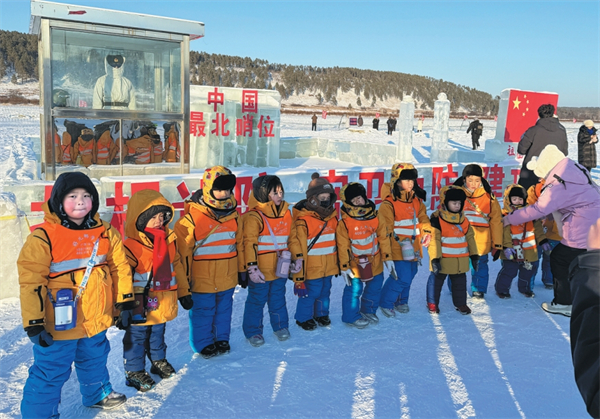Home>Customs
The sweet magic of Harbin's sugar figurines
Updated : 2023-01-11
By ( China Daily )

Wang works at one of her sugar figurine stores. [Photo for China Daily]
Inheritor is one of few women in the country recognized for art.
Children gaped as they watched Wang Chunjing create a lifelike rabbit out of molten maltose in minutes at her stall in Harbin, Heilongjiang province.
Their reactions did not surprise the 32-year-old, who has been blowing sugar figures, a traditional Chinese folk art, for more than a decade.
The process begins with heating sugar syrup, drawing out a small portion, kneading it into a ball with a hollow center, pinching the edges together and stretching it into a tube.
The maker then blows air into the tube and molds the sugar ball into different shapes. "To make a successful piece, I have to do it all in three minutes," Wang said.
Born in Heilongjiang's Qinggang county, she understands the children's reactions because she too once watched in amazement as her father did the same thing when she was a child. "He learned from my grandfather and mastered sugar figurine making to support the family," she said. "But from my perspective as a child, he was more like a magician."

Wang Chunjing makes sugar figurines at one of her stores in Harbin, Heilongjiang province. [Photo for China Daily]
Showing both interest and talent, Wang was able to make easy shapes, like a gourd, with sugar syrup by the time she was 6.
After graduating from senior high school in 2008, her family moved to Harbin, the provincial capital, in search of a better life. "My father hoped I'd find get a stable job, and I tried several in Harbin, including as an assistant at a clothing shop and a mobile phone shop," she said. "However, I still dreamed of becoming a figurine maker to create magic like my father."
Upon her insistence, he finally agreed to take her on as his student. She spent three years mastering the skills and then traveled to different provinces, including Guangdong, Yunnan, Sichuan and Fujian, and the Guangxi Zhuang autonomous region to earn a living by making sugar figures.

In 2015, Wang decided to return to Harbin, where her parents live. "I like the city, and my boyfriend at that time, one of my father's students, also hoped to begin a stable life here," she said. "Then we started our sugar figurine business, which brought us lots of followers who wanted to learn."
Over the past years, they have taught 12 students from across the country.
The couple married in 2018 and have opened three stalls in famous tourist spots around the city. Now, their figurines are appreciated by residents and tourists alike.
"Most of them are a light brown color, but I can make them into different colors," she said. "I also pay a lot of attention to refining details, such as the nose, eyes and mouth."
Wang has also tried out ideas for new shapes and figures.

To celebrate the successful return of one of the country's rocket crews, Wang spent three days creating the sugar figure of an astronaut. "I can't remember how many times I failed," she said. "But I wasn't discouraged, and after working out what I was doing wrong, I finally created a satisfactory figurine — finally succeeding, just as the country had succeeded in sending a rocket into space."
In 2006, sugar figurine making was listed as a national-level intangible cultural heritage, and in 2019, Wang was granted the title of provincial-level inheritor.
"As far as I know, there are fewer than 100 people in China who can make sugar figures, and even fewer are young female inheritors," she said. "It is not easy to make innovations to an intangible cultural heritage, but I will persevere."
Every month since 2017, Wang and a group of folk artists visit rural schools in Harbin, teaching students about traditional art forms such as paper cutting and clay sculptures.
The students also get to make figures of their own under their guidance. "We were all very happy to discover that the students were really interested in these traditional arts," she said. "Making sugar figurines is not just a precious childhood memory, it also brings me great happiness and joy. I hope to teach more people about the art and traditional culture."

Harbin ramps up childcare services
A new comprehensive service center for childcare in Harbin is expected to be finished by the end of the year.
-
Talent policies drive enterprise development in Harbin
Harbin's "30 New Talent Policies" represents an iterative upgrade to the talent policy system, helping attract and retain talent to bolster economic and social development.
-
Official website of 2025 Asian Winter Games goes live
Harbin, the host city of the 9th Asian Winter Games, has announced that the official website for the 2025 event has recently gone live.
-
Harbin launches measures to facilitate more foreign trade
In the first three quarters of 2023, the total import and export value of Heilongjiang province's goods trade hit 218.22 billion yuan.





